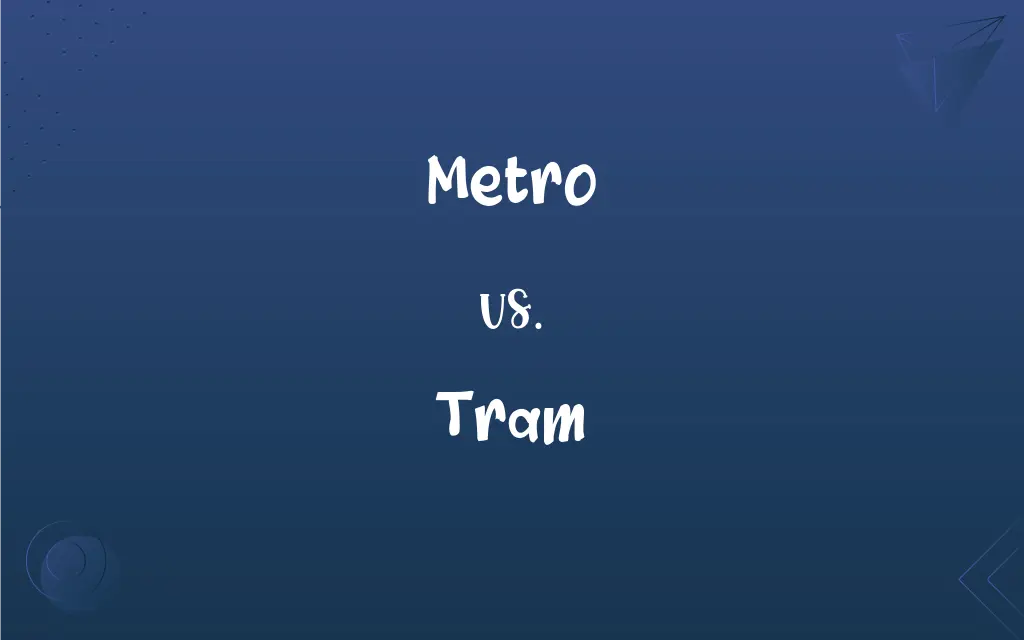Metro vs. Tram: What's the Difference?
Edited by Janet White || By Harlon Moss || Updated on November 2, 2023
A metro is a high-capacity urban underground train system, while a tram is a street-level rail vehicle for public transport.

Key Differences
The metro, an abbreviation of metropolitan railway, is usually an underground urban train system designed for high-volume passenger traffic. Trams, on the other hand, are rail vehicles that run on tracks along public urban streets and sometimes on separate tracks. Metros are characterized by their high speed and frequent service, operating mainly within cities, while trams are slower, often sharing space with road traffic, and can extend to suburban areas.
Metros typically have their own dedicated tracks that are separate from other traffic, allowing for uninterrupted service across dense urban areas. Trams, alternatively, integrate more with street traffic and may have designated lanes or mixed traffic lanes, leading to a more accessible but sometimes slower service. Metros are part of rapid transit systems with wider station spacing and high capacity, whereas trams stop more frequently and are best for short to medium distances.
The metro system is often the backbone of a city's public transport, offering fast and frequent services. Trams, regarded as a complementary transport mode, often serve as feeders to larger transport systems like the metro. While metros can handle a larger volume of passengers and are typically used for longer, uninterrupted commutes, trams excel in areas with lower density, serving local communities with stops that are closer together.
One can find metros in many of the world's major cities, carrying millions of passengers daily. Trams, also popular in urban environments, are more often seen in cities with narrower streets and historical areas where the construction of metro lines may not be feasible. Metros require significant infrastructure and investment, suggesting a commitment to long-term urban planning, while trams can be seen as a more flexible and often less expensive option.
In summary, both metros and trams are vital components of urban transportation, yet they serve distinct roles based on capacity, speed, and integration with the city infrastructure. The metro offers fast, high-capacity travel underground, whereas trams provide more localized, street-level service.
ADVERTISEMENT
Comparison Chart
Environment
Underground/subterranean
Street-level
Route Design
Dedicated tracks, separate from traffic
Tracks on public roads, often mixed with traffic
Service Speed
Fast and high-frequency
Slower with more frequent stops
Passenger Capacity
High capacity
Lower capacity
Area of Service
Dense urban centers
Urban and suburban areas, including streets
ADVERTISEMENT
Metro and Tram Definitions
Metro
A train system that operates on exclusive right-of-way tracks.
The metro was delayed due to maintenance on the tracks.
Tram
An electrically powered public transportation vehicle on rails.
They replaced the bus service with a more environmentally friendly tram.
Metro
An underground urban railway system for mass transit.
She takes the metro to work every day to avoid traffic.
Tram
A carriage or car on rails for carrying passengers.
The crowded tram inched its way through the morning rush.
Metro
A subway or rapid transit train in a metropolitan area.
The Paris metro has become a symbol of the city itself.
Tram
A rail vehicle that runs on tracks along public urban streets.
He hopped on a tram to tour the downtown area.
Metro
A network of high-speed trains serving an urban area.
The new metro line will connect the city center to the airport.
Tram
A light rail vehicle, often part of an urban public transport system.
The tram lines in the city center are highly efficient.
Metro
The full form of metropolitan railway, often in a large city.
The metro area includes the city and the surrounding suburbs.
Tram
A streetcar or trolley used for public transport.
The city's historic tram is still operational for tourists.
Metro
(general) A rapid transit rail transport system, or a train in such systems, generally underground and serving a metropolitan area.
Tram
A streetcar.
Metro
(less common) An urban rapid transit rail transport system, normally with lighter track and light trains (i.e. an S-Bahn or similar), or a train in such systems.
Tram
A streetcar line.
Metro
A metropolitan area.
Tram
A cable car, especially one that rolls along an overhead cable along which it is drawn by a second, moving cable.
Metro
Metropolitan
Metro
Electric underground railway
FAQs
Can trams be part of a metro system?
Trams usually operate independently but can connect to metro systems.
How fast does a metro travel?
Metros travel quickly, often surpassing the speed of road traffic.
Is a metro considered light rail?
No, metros are typically part of a heavy rail, rapid transit system.
Can trams carry as many passengers as metros?
No, trams usually have lower passenger capacities than metros.
Are trams slower than buses?
Trams can be slower in mixed traffic but often have priority signaling.
Do metros stop as frequently as trams?
No, metro stops are less frequent with greater distances between them.
What is a metro?
A metro is an urban, high-capacity underground railway system for cities.
What is a tram?
A tram is a street-level rail vehicle that runs on urban streets for public transport.
Do metros run above ground?
While primarily underground, some metro systems have above-ground sections.
Can bikes be taken on a metro?
Some metros allow bikes during certain hours or in specific cars.
Do trams run on a similar schedule to buses?
Tram schedules can be similar to buses, often with higher frequency.
Is a metro ticket more expensive than a tram ticket?
Ticket pricing varies by city; metros can be more expensive due to longer distances.
Are all trams electric?
Modern trams are usually electric, but some historic trams may not be.
Are pets allowed on the metro?
Policies on pets vary; some metros allow them in carriers.
Are metros accessible to people with disabilities?
Most metro systems are designed to be accessible.
Do trams have their own dedicated lanes?
Some trams have dedicated lanes, while others share roads with vehicles.
What's the main advantage of taking a tram?
Trams offer convenient stops and often scenic routes in urban areas.
Can trams be a tourist attraction?
Yes, historic or scenic tram routes can be popular with tourists.
Are trams used in rural areas?
Trams are generally not used in rural areas; they're urban or suburban.
Is it faster to take the metro during rush hour?
Yes, metros are typically faster as they avoid road traffic.
About Author
Written by
Harlon MossHarlon is a seasoned quality moderator and accomplished content writer for Difference Wiki. An alumnus of the prestigious University of California, he earned his degree in Computer Science. Leveraging his academic background, Harlon brings a meticulous and informed perspective to his work, ensuring content accuracy and excellence.
Edited by
Janet WhiteJanet White has been an esteemed writer and blogger for Difference Wiki. Holding a Master's degree in Science and Medical Journalism from the prestigious Boston University, she has consistently demonstrated her expertise and passion for her field. When she's not immersed in her work, Janet relishes her time exercising, delving into a good book, and cherishing moments with friends and family.































































